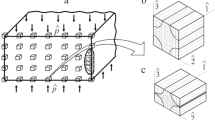A method is proposed for calculating the near-surface effect in piecewise homogeneous bodies under large deformations based on a combined use of one-level applied and two-level carcass theories. The applied theory is used for a macromechanical continuation of the solution of the problem, but the carcass theory is used in the final part of the loading path or directly at the final loading of the body. The implementation of the problem by the carcass theory for the body as a whole ends with solution of extreme problems using a highly gradient scheme for assemblies of structural blocks near boundary surfaces of the body. The rotation-caused development of configurations of cylinders reinforced with ring fibers is studied using this method and the model of a piecewise homogeneous medium. The results obtained by the carcass theory and the model of a piecewise homogeneous medium differed only slightly, confirming the high accuracy of the analysis using the two-level approach. A higher stability of the numerical implementation of the carcass theory, in comparison with the model of a piecewise homogeneous medium, was revealed when the macromechanical continuation was carried out within the framework of this theory itself. An even higher stability of the approach was reached by implementation of the macromechanical continuation of the applied theory. Performing calculations only for nodal blocks of the medium at the micromechanical level of the carcass theory, together with application of the applied theory for the macromechanical continuation, led to an extremely high efficiency of the two-level approach. In contrast to the piecewise homogeneous medium model, this approach made it possible to study the behavior of piecewise homogeneous cylinders considering the near-surface effect up to the configurationdetermined ultimate rotation speed.








Similar content being viewed by others
References
A. A. Rassoha and V. O Kaledin, “On the deformation of a fiber-reinforced layered composite near to a free surface,” Prikl. Mekh., 20, No. 9, 91-97 (1984).
V. Yu. Bojchuk, “Research of edge effects in a composite weakly reinforced with rectangular fibers,” Prikl. Mekh., 37, No. 5, 126-132 (2001).
Yu. V. Kokhanenko and V. M. Bystrov, “Edge effect in a fibrous composite material in uniform loading of near-surface fibers,” Prikl. Mekh., 43, No. 11, 15-23 (2007).
Yu. V. Kokhanenko and S. V. Fesenko, “Parameters of effects as functions of the mechanical characteristics of a composite weakened by a crack on the interface of layers,” Prikl. Mekh., 39, No. 12, 93-99 (2003).
I. V. Andrianov, V. V. Danishevs’kyy, and D. Weichert, “Analytical study of the load transfer in fiber-reinforced 2D composite materials,” Int. J. of Solids and Structures., 45, Mar., 1217-1243 (2008).
J. Harich, Y. Lapusta, and W. Wagner, “3D FE-modeling of surface and anisotropy effects during microbuckling in fiber composites,” Compos. Struct., 89, Aug., 551-555 (2009).
L. Banks-Sills and V. Leiderman, “Macro-mechanical material model for fiber reinforced metal matrix composites,” Composites: Part B, 30, Jan., 443-452 (1999).
J. Fish, “The s-version of the finite element method,” Computers and Structures, 43, May, 539-547 (1992).
V. M. Akhundov, “Applied theory of composites with low fillings by strings at high deformations,” Mekh. Kompoz. Mater. Konstr., 7, No.1, 3-15 (2001).
V. M. Akhundov, “Carcass theory of fibrous media with uncurved and locally curved fibers at large deformations,” Mech. Compos. Mater., 51, No. 6, 971–990 (2015).
V. M. Akhundov, “Form changes of a toroidal body with a crossed arrangement of fibers on the basis of the two-level carcass theory,” Mech. Compos. Mater., 53, No. 2, 359-378 (2017).
M. P. Galanin and E. B. Savenkov, “Joint use of the method of finite elements and the method of finite superelements,” Preprity Inst. Prikl. Mekh. RAN, М., 34 p. (2004).
V. M. Akhundov and T. A. Skripochka, “Large deformations of homogeneous and fiber-reinforced cylinders under the influence of centrifugal forces,” Mech. Compos. Mater., 45, No. 3, 347-366 (2009).
V. M. Akhundov, “Analysis of elastomeric composites based on fiber-reinforced systems. 1. Development of design methods for composite materials,” Mech. Compos. Mater., 34, No. 6, 733-745 (1998).
V. M. Akhundov and M. M. Kostrova, “Nonlinear deformation of a piecewise homogeneous cylinder under the action of rotation,” Mech. Compos. Mater., 54, No. 2, 345-360 (2018).
R. M. Christensen, Mechanics of Composite Materials, John Wiley & Sons, New Yorc–Chichester–Brisbane–Toronto (1979).
F. L. Chernous’ko and V. P. Banichuk, Variational Problems of Mechanics and Control [in Russian], M., Nauka (1973).
O. K. Zenkevich and K. Morgan, Finite Elements and Approximation, M., Mir, (1986).
G. A. Korn and T. M. Korn, Mathematical Handbook for Scientists and Engineers: Definitions, Theorems and Formulas for Reference and Review, N.Y.: General Publ. Company (2000).
J. Ortega and V. Reiboltd, Iteration Methods of Solution of Nonlinear Systems of Equations with Many Unknowns, M., Nauka (1975).
S. K. Gupta and K. K. Tanji, “Computer program for solution of large, sparse, unsymmetric systems of linear equations,” Int. J. for Numerical Methods in Engineering, 11, No.8, 1251-1259 (1977).
K. F. Chernykh, Nonlinear Elasticity Theory of in Machine-Building Calculations [in Russian], L., Mashinostroenie (1986).
S. I. Dymnikov, E. E. Lavendel, A.-M. Pavlovskis, and M. I. Sniegs, Applied Methods of Calculation of Products from Highly Elastic Materials [in Russian], Riga, Zinatne (1980).
Author information
Authors and Affiliations
Corresponding author
Additional information
Translated from Mekhanika Kompozitnykh Materialov, Vol. 56, No. 2, pp. 253-278, March-April, 2020.
Rights and permissions
About this article
Cite this article
Akhundov, V.M. Method for Calculating the Near-Surface Effect in Piecewise Homogeneous Bodies at Large Deformations Based on a Two-Level Approach. Mech Compos Mater 56, 169–184 (2020). https://doi.org/10.1007/s11029-020-09870-w
Received:
Revised:
Published:
Issue Date:
DOI: https://doi.org/10.1007/s11029-020-09870-w



